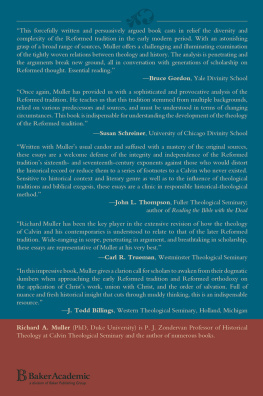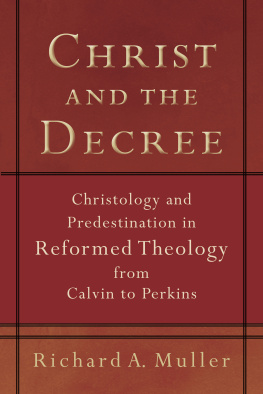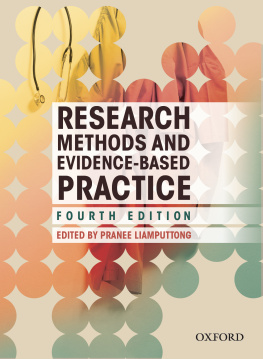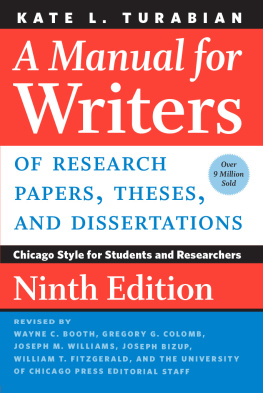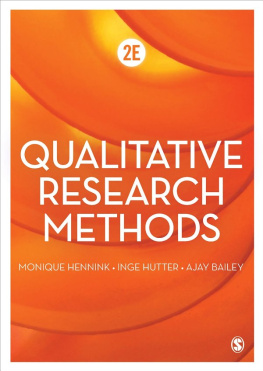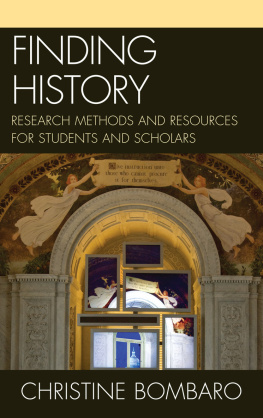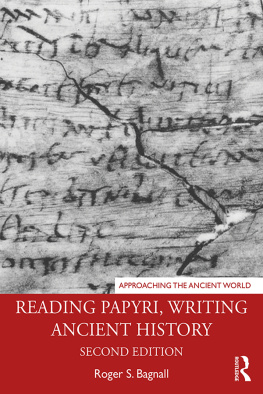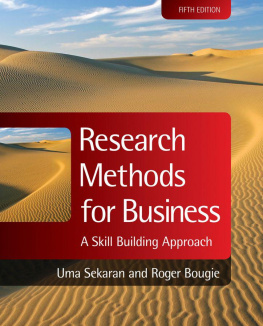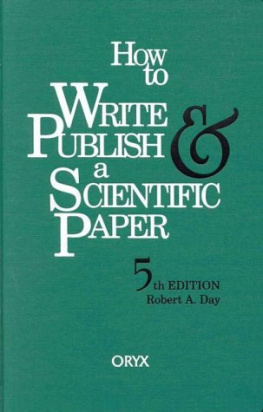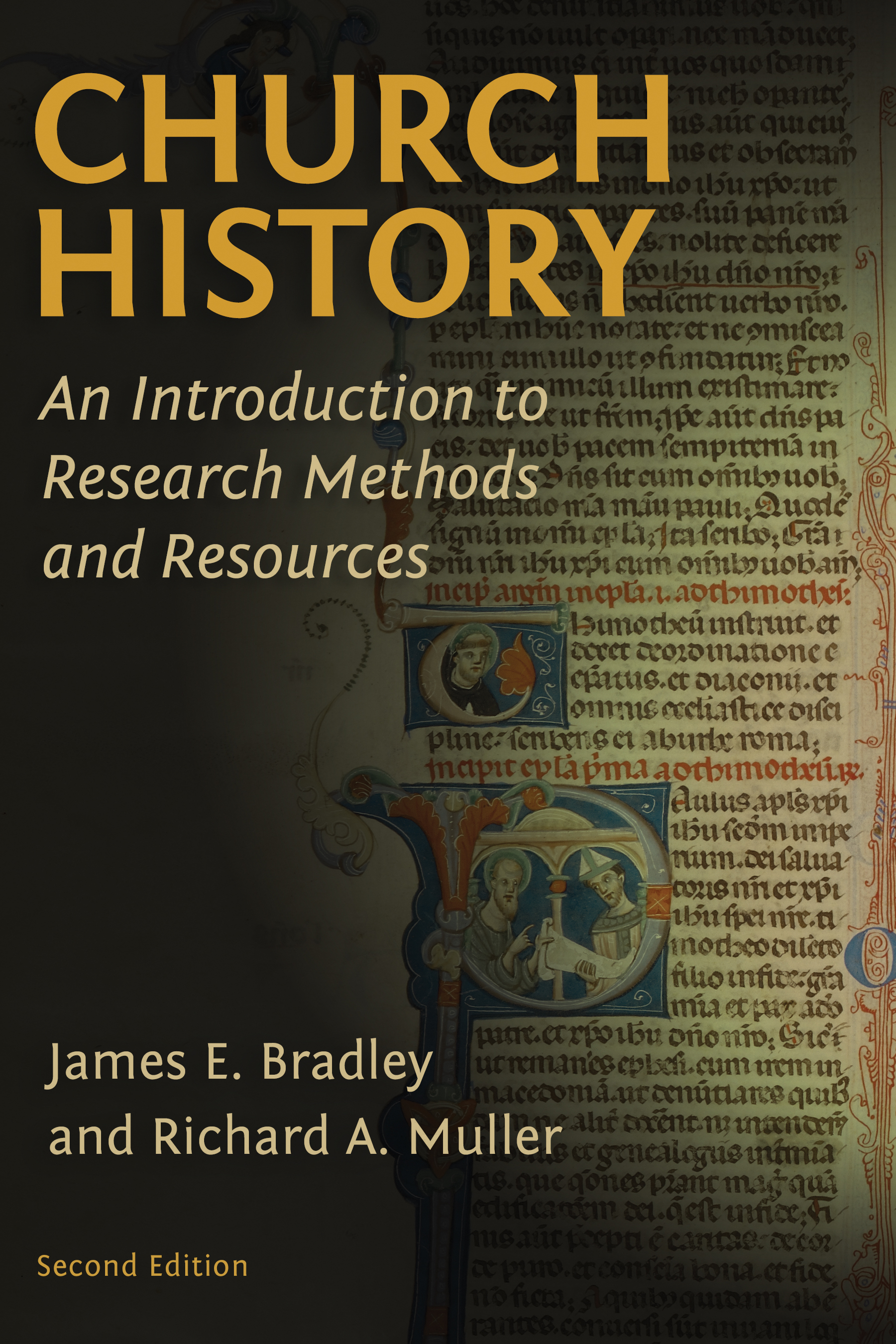Church History
An Introduction to
Research Methods and Resources
Second Edition
James E. Bradley & Richard A. Muller
William B. Eerdmans Publishing Company
Grand Rapids, Michigan / Cambridge, U.K.
1995, 2016 James E. Bradley and Richard A. Muller
All rights reserved
First edition published 1995
Second edition published 2016 by
Wm. B. Eerdmans Publishing Co.
2140 Oak Industrial Drive N.E., Grand Rapids, Michigan 49505 /
P.O. Box 163, Cambridge CB3 9PU U.K.
Printed in the United States of America
Library of Congress Cataloging-in-Publication Data
Names: Bradley, James E., 1944- | Muller, Richard A. (Richard Alfred), 1948- author.
Title: Church history : an introduction to research methods and resources /
James E. Bradley & Richard A. Muller.
Description: Second edition. | Grand Rapids, Michigan :
William B. Eerdmans Publishing Company, 2016. |
Includes bibliographical references and indexes.
Identifiers: LCCN 2015045615 | ISBN 9780802874054 (pbk. : alk. paper)
eISBN 9781467445108 (ePub)
eISBN 9781467444637 (Kindle)
Subjects: LCSH: Church historyStudy and teaching. |
Church historyResearchMethodology. | Church historyHistoriography. |
Church historyBibliography. | Church historyReference books.
Classification: LCC BR138 .B69 2016 | DDC 270.072dc23
LC record available at http://lccn.loc.gov/2015045615
www.eerdmans.com
Contents
1. Introduction to Church History and
Related Disciplines
6. Preparing Lectures and
Writing Monographs and Articles
A. Online Databases and Scholarly Commercial
Database Projects
W e have been pleased by the positive reviews of the first edition of this book and reassured by the number of research students who have found the guidance offered here to be useful. While the overall aim of this second, revised edition remains much the same as the first, a brief sketch of the main changes in the present volume may be desirable. The new edition includes the latest information on primary source materials in the fields of church history and historical theology. In addition, new and revised studies of secondary reference works and research tools have almost doubled the number of titles in our bibliography since the first edition. The most sweeping changes since 1995 continue to be in the area of the digitization of texts and greater access to both primary texts and scholarly books and articles on the Internet.
Our assumptions about processes of research, approaches to collation and analysis of materials, balance of primary and secondary sources, and organization of essays remain largely unchanged in fundamental principle, but are now nuanced by further reflection on the implications of the increasing availability of new and more detailed sources. Hence the discussion of research on the Internet, digitized texts, the electronic form of research tools, and their use accounts for the most substantial additions to the present volume. In the following paragraphs we note in brief a few of the more important scholarly projects that illustrate the ongoing revolution in the availability of primary source materials in digital form, along with some of the more important new scholarly tools specifically for students of church history.
In 1995 we were impressed with the comprehensive listing of primary printed source titles and their library locations worldwide in such works as The Eighteenth Century Short Title Catalog. We knew that scanning texts and optical character recognition would gradually make more full-text sources available, but at the time we did not fathom the scale of the change or the rapidity with which it would occur. Early English Books Online had already rendered all important English texts in digital facsimile from the beginning of printing through 1700 (about 125,000 works), but because of the sheer mass of printed sources for the eighteenth and nineteenth centuries similar treatment seemed beyond reach. However, the physical process of handling books for digitization was transformed in 2004 by robotics (Kirtas Technologies), so that primary printed English texts for virtually the entire eighteenth century and much of the nineteenth century soon appeared. In very short order, Thomson/Gales commercial project, the Eighteenth Century Collections Online, made 205,000 primary printed English texts available for all important titles for the eighteenth century. Between 2005 and 2008 Microsoft Corporation, in collaboration with the British Library, digitized 750,000 mostly nineteenth-century books. During this period and since, the global reach of Google Books and its vast libraries of texts rendered by optical character recognition has become proverbial.
Scholars had long recognized various problems with optical character recognition, including matters of its accuracy and the inability to fully search scanned texts. Additionally, many online projects were commercial in nature and remain prohibitively expensive and available only through major research libraries. The Text Creation Partnership has set out to remedy these drawbacks by actually in-putting through key-boarding the text of each unique English title through 1800. This alliance of some 150 universities worldwide will not only eventually make all these texts fully searchable, but also allow open access. It may be worth noting that what was begun in English-language primary sources has now extended to western languages generally. The short title catalog for books published in German-speaking lands for the period 1501-1600 (VD 16) was completed in the year 2000, and in 2007 French Vernacular Books offered a short title catalog for books printed in French before 1601. These efforts gave birth to the modestly entitled Universal Short Title Catalog project hosted by the University of St. Andrews, which aims ultimately to offer a pan-European technical bibliography of early books, many in full text, in a single online open access platform. Since 2007, early modern books published in the Iberian Peninsula have been added, as well as Latin books published in France. In addition to providing the researcher with complete technical bibliographies, the German project, as one example, has already digitized more than thirty percent of sixteenth-century books and promises that by 2020, the entire corpus of books published in German-speaking lands through 1800 will be digitized, all with open access.
The accessibility of manuscripts also represents an important development since our first edition. A few manuscript collections were available in the mid-1990s in digital form via the Internet, and web searches of at least the listing of the holdings of a limited number of archives were possible through OCLC and RLIN. Presently, however, there is a growing effort to make unpublished manuscript sources readily available to scholars. Major manuscript collections such as the unpublished works of Jonathan Edwards and Benjamin Franklin (both projects hosted by Yale University) are now accessible as fully searchable exact replicas, with marginalia. In short, open access to primary source materials in the field of history, whether in the form of print or manuscript, is unquestionably the trend of the future. As the older technologies that involved the use of microfilm and CD-ROM recede in importance, our revised edition of this book aims to take account of these new developments and provide students with guidance in the access and use of primary source materials.
Beyond primary sources, our bibliography has added about 450 titles of reference works, research tools, and sources, most published since 1995, and we have annotated about one in six of these titles. Many reference works, especially older ones that are out of copyright, have been digitized by Google Books, Project Gutenberg, and the Internet Archive, among others, but it proved to be impossible for us to list all reference works that are now available online. We have noted, however, some of the most important, enduring scholarly tools and where to locate them. Journals and Series now run to over 100 entries in our bibliography, which represents a threefold increase over the first edition. The proliferation of series of scholarly monographs and texts is especially notable, in that more than twenty new series that are pertinent to the study of church history and historical theology have appeared since 1995. Publishers of both series and journals have deepened and expanded the amount of information that they offer online. Even when full access to articles is denied, and it typically is, the titles of most journal articles with abstracts are freely available, and while Journal Storage (JSTOR) is still the first avenue for research, the trend to move journals online and make articles available for purchase is unmistakable.


